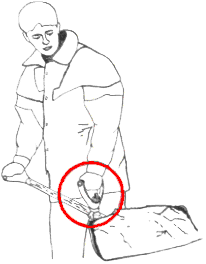Definition
Ergonomics (from the Greek word ergon meaning work, and nomoi meaning natural laws), is the science of refining the design of products to optimize them for human use. Human characteristics such as height, weight and proportions are considered. Ergonomics is sometimes known as human factors engineering.
Posture
In recent years, ergonomists have attempted to define postures which minimize unnecessary static work and reduce forces acting on the body. All of us could significantly reduce our risk of injury if we could adhere to the following ergonomic principles:
- All work activities should permit the worker to adopt several different, but equally healthy and safe postures with varying tasks.
- Where muscular force has to be exerted it should be done by the largest appropriate muscle groups available.
- Work activities should be performed with the joints at about mid-point of their range of movement. This applies particularly to the head, trunk and upper limbs.
Proper Garden Tool
Using the proper tool is a vital part of successful gardening. Every gardener knows that, without proper gardening tools, no garden will give you the success you desire. In adapting the garden to the needs of every gardener, a variety of tools are available. Whatever style of tool you choose, there are a few universal pointers that will help you as you garden:
- Use tools with the right size grip - To find the right fit, make a circle with your index finger and thumb, that is the size the grip of your tools should be. Larger grips are easier to hang on to.
- Try to find tools with a depression or ridge in the handle for your thumb to rest on, this will keep your hand in the proper alignment.
- For back pain relief use tools with longer handles to cut down on the need to bend over.
- Keep tools sharp and in good condition to conserve energy.
- Use the lightest weight tool possible to complete tasks, especially if your arms and hands are weak.
- Work to keep your back straight and your joints in neutral positions to reduce arthritis pain and prevent repetitive stress injury.
- Use tools with a soft, pliable handle for easier gripping.
- Use nonslip surfaces so as not to waste energy gripping tools too tightly.
Proper Vacuuming
To vacuum, use a "fencers stance." Put all your weight on one foot, then step forward and back with the other foot as you push the vacuum forward and back. Use the back foot as a pivot when you turn.
Proper Snow Shoveling
To shovel, keep your back straight and bend from the knees, not from the waist. As you lift, hold the snow shovel as close to your body as possible. If you have to turn, step in the direction of the turn.
Hand Grips for Carpal Tunnel Syndrome - prevent the pain in your hands & wrists
Carpal tunnel syndrome is a painful disorder of the wrist and hand. The carpal tunnel is a narrow tunnel formed by the bones and other tissues of your wrist. This tunnel normally protects your median nerve. The median nerve gives you feeling in your thumb, and index, middle and ring fingers. But when other tissues in the carpal tunnel, such as ligaments and tendons, get swollen or inflamed, they press against the median nerve. That pressure can make part of your hand hurt or feel numb.
Symptoms of carpal tunnel syndrome
- Numbness or tingling in your hand and fingers. You may feel this the most in your thumb and index and middle fingers.
- Pain in you wrist, palm or forearm.
- More numbness or pain at night than during the day. You may shake or rub your hand to get relief.
- More pain as you use your hand or wrist more such as when driving.
- Trouble gripping objects.
- Weakness in your thumb.
Making the same hand movements over and over can lead to carpal tunnel syndrome. It's most common in people whose jobs require pinching or gripping with the wrist held bent. People at risk include typists, people who use computers, carpenters, grocery checkers, assembly-line workers, meat packers, violinists, mechanics, or anyone using vibrating machinery. Hobbies such as gardening, needlework, golfing and canoeing can sometimes bring on the symptoms. Carpal tunnel syndrome isn't usually serious. With treatment, the pain will usually go away and you'll have no lasting damage to your hand or wrist.
Tips on easing carpal tunnel syndrome:
- Avoid bending your wrists down for long periods.
- Find a new way to use your hand by using a different tool.
- Try to use the other hand more often.
- Avoid using your hand too much.
- Prop you arm with pillows when you lie down.
Things that may help prevent carpal tunnel syndrome:
- If you do the same tasks with your hands over and over, try not to bend, extend or twist your hands for long periods.
- Switch your hands during work tasks.
- Hold objects instead of pinching them.
- Make sure your tools aren't too big for your hands.
- Don't work with your arms too close or too far from your body.
- Use tools that don't vibrate too much.
- Take regular breaks from repeated hand movements to give your hands and wrists time to rest.
- Don't sit or stand in the same position all day.
- Don't rest your wrists on hard surfaces for long periods.
- If you use a computer or type a lot, adjust the height of you chair so that your forearms are level with your keyboard and you don't have to flex your wrists to type.
Factors such as price, performance and durability are important considerations in choosing tools.
If a tool is uncomfortable or awkward to use you will regret buying it.
The interaction between you and the tool is called ergonomics.





